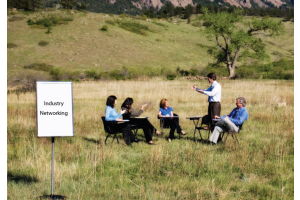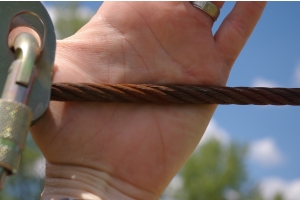keith jacobs
-
November 06, 2021
Cargo nets are a versatile and useful tool that can be used for a variety of purposes. They are ideal for storing and transporting heavy objects, and they can also be used to create temporary barriers or enclosures. Cargo nets are also a popular choice for playgrounds, ropes courses, obstacle courses, ninja courses, and other recreational structures.
Cargo nets are made by weaving together a series of ropes or cords. The ropes or cords are typically made of polydacron, nylon, polyester, hemp or manilla, and they are woven together or knotted in a variety of patterns, depending on the desired shape, strength and flexibility of the net needed for your application.
The size of a cargo net is determined by the length and width. The length and width of the net are measured from one end to the other. Cargo nets can take many shapes like square, rectangle, triangular, octagonal, and circular to name a few common shapes.
The strength of a cargo net is determined
-
February 22, 2021
What is a ropes course?
A ropes course is an outdoor activity course that uses ropes and other equipment to challenge participants physically and mentally. Ropes courses can be found at adventure parks, outdoor education centers, and other recreation facilities. They are typically designed for groups of people, but some courses can be completed individually.
What are the benefits of doing a ropes course?
There are many benefits to doing a ropes course, including:
- Improved physical fitness
- Increased self-confidence
- Enhanced teamwork skills
- Reduced stress levels
- Increased sense of accomplishment
- Fun and excitement!
Who can do a ropes course?Ropes courses are open to people of all ages and abilities. However, some courses may have height or weight restrictions. It is always best to check with the course operator before participating.
-
February 16, 2021
Challenge courses and aerial adventure parks are a popular form of outdoor recreation that offer participants a challenging and exciting experience. However, the cost of starting and operating a challenge course or aerial adventure park can be high. There are a number of financing options available to help entrepreneurs start and grow their businesses in this industry.
One option is to obtain a loan from a bank or other financial institution. Loans can be used to finance the purchase of land, equipment, and other startup costs. The terms of a loan will vary depending on the lender, the amount of the loan, and the borrower's creditworthiness. Experiential Systems offers financing for challenge courses, aerial adventure parks, zip lines and asociatied equipment - check out the site for more infomration. -
August 02, 2020
Wire rope is a mainstay and central component of modern ropes course, challenge course and zip line installations. In teh ropes course and zipline industry we typically utalize flexible wire rope like 1/4" to 3/8" GAC (Galvanized Aircraft Cable)or IWRC (Independant wire rope core) in sizes up to 1". It's important for designers, installers, inspectors and operators to understand some basics on wire rope design and inspection.
Wire rope construction
Wire rope is made up of a number of individual wires that are twisted together. The wires can be made of a variety of materials, including steel, stainless steel, and aluminum. The type of material used will depend on the application. For example, steel wire rope is strong and durable, but it is also heavy. Stainless steel wire rope is corrosion resistant, but it is also more expensive than steel wire rope. Aluminum wire rope is lightweight, but it is not as strong as steel or stainless steel wire
-
May 06, 2020
Rope courses and ziplines are a great way to have fun and get exercise, but they can also be dangerous if the trees they are built in are not healthy. That's why it's important to have a certified arborist conduct a level 2 inspection to assess the tree health before installing a ropes course or zipline.
A level 2 inspection is a more thorough inspection than a level 1 inspection. A level 2 inspection will include:
- A visual inspection of the tree's overall health and condition.
- An inspection of the tree's roots, trunk, and branches.
- An inspection of the tree's surrounding area for potential hazards.
- An inspection of where elements and componenets of the challenge course or ropes course connect with the tree
If the certified arborist finds any problems with the tree, they will recommend repairs or removal. It is important to follow the arborist's recommendations to ensure the safety of your ropes course or zipline.
-
April 08, 2020
Inspecting utility poles is an important part of ensuring the safety of challenge course participants. By inspecting utility poles below grade, you can identify potential hazards and take steps to mitigate them.
What to Look For
When inspecting a utility pole below grade, you should look for the following:
- Settlement: Utility poles can settle over time, which can cause them to lean or tilt. If a utility pole is leaning or tilting, it is important to have it repaired or replaced.
- Corrosion: Utility poles are made of wood or concrete, and both materials can corrode over time. If you see any signs of corrosion on a utility pole, it is important to have it repaired or replaced.
- Damage: Utility poles can be damaged by a variety of things, including weather, pests, and accidents. If you see any damage to a utility pole, it is important to have it repaired or replaced.
-
February 14, 2020
Belay devices are essential pieces of equipment for rock climbers, ropes course staff, zip line guides, rappellers, and others who work or recreate in high places. They are used to control the rope and prevent falls while climbing or ascending. There are many different types of belay devices available, each with its own advantages and disadvantages.
- Tubular belay devices are the most common type of belay device. They are simple to use and can be used for a variety of applications. Tubular belay devices work by creating friction on the rope as it passes through the device. This friction helps to control the rope and prevent falls.
- Assisted braking belay devices are a type of belay device that helps to reduce the risk of a fall. Assisted braking devices have a mechanism that automatically locks the rope in place if a fall occurs. This can help to prevent serious injury or death.
- Figure-8 descenders are a
-
November 17, 2019
A rope ascender is a mechanical device that allows you to move up a rope. It is a vital piece of equipment for rock climbers, tree climbers, arborists, ropes course installers, challemnge course technitians, zip line inspectors and other workers who need to ascend ropes for fun or for work.
There are many different types of rope ascenders available, so it is important to choose one that is right for your needs. Some factors to consider when selecting an ascender include:
- The type of rope you will be using. Ascenders are designed to work with specific types of ropes. Make sure to choose an ascender that is compatible with the type and size of rope you will be using.
- The weight capacity of the ascender. Ascenders have different weight capacities, so make sure to choose one that can support your weight and teh weight of any materials and tools connecteed to you or the ascender.
- The type of locking mechanism. Ascenders have different types of
-
September 11, 2019
A ropes course and/or zip line harness is one of the most important pieces of gear for an oporator to purchase. It is essential for your staff and participant safety when on a challenge course or zipline, and it can make a big difference intheir comfortand teh overall expericece. There are many different factors to consider when choosing a harness, so it is important to do your research and find the one that is right for you.
Style
Ropes course and zip line harnesses come in a variety of styles: Sit harnesses, sit harnesses with chest harnesses, full body harenesses and specialty harnesses for accessability or being suspended in a prone or superman position. Its imprtant to select a harness that prevents inversion whil eengaging in the activity. While ist common to wear sit harnesses while rock climbing and on some challneg course elements, best practice would be to use a sit harness with a chest harness or better yeat a full body harness.
Materials
-
May 22, 2019
Challenge courses are a great way for people of all ages to get exercise, learn new skills, and have fun. However, they can also be dangerous if not properly supervised. That's why it's important to use the right safety equipment, including a continuous belay system or smart belay system.
A continuous belay system is a type of belay system that uses a segmented or continuous belay cable or track that a lanyard or trolley connects to once without transferring. A lanyard is connected to the belay cable or track with a hook or trolley that can only come on and off at the start and end of the course or with a special tool used by staff or monitors. The lanyard is then attached to the participant’s harness. A continuous belay system prevents users from becoming unclipped while in the air on the ropes course.
A smart belay system is a type of modern lanyard system that uses








